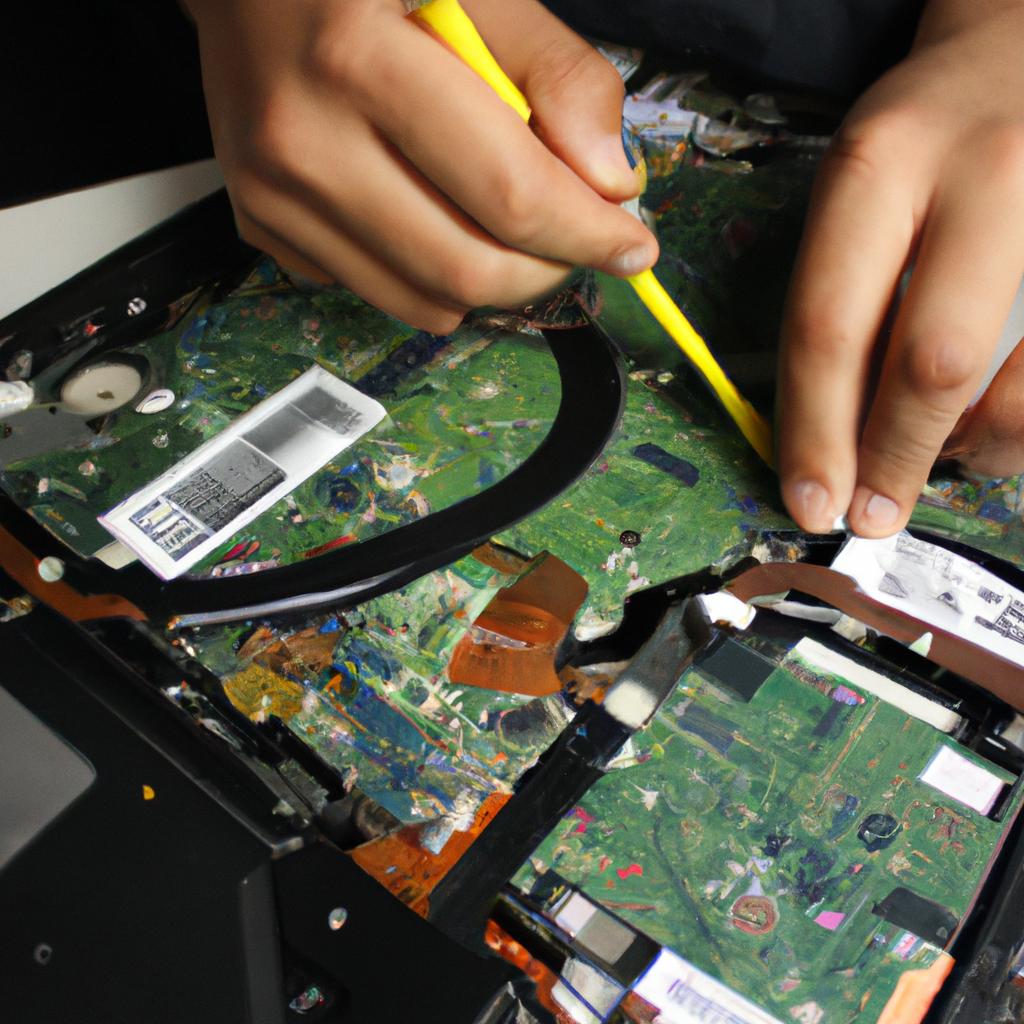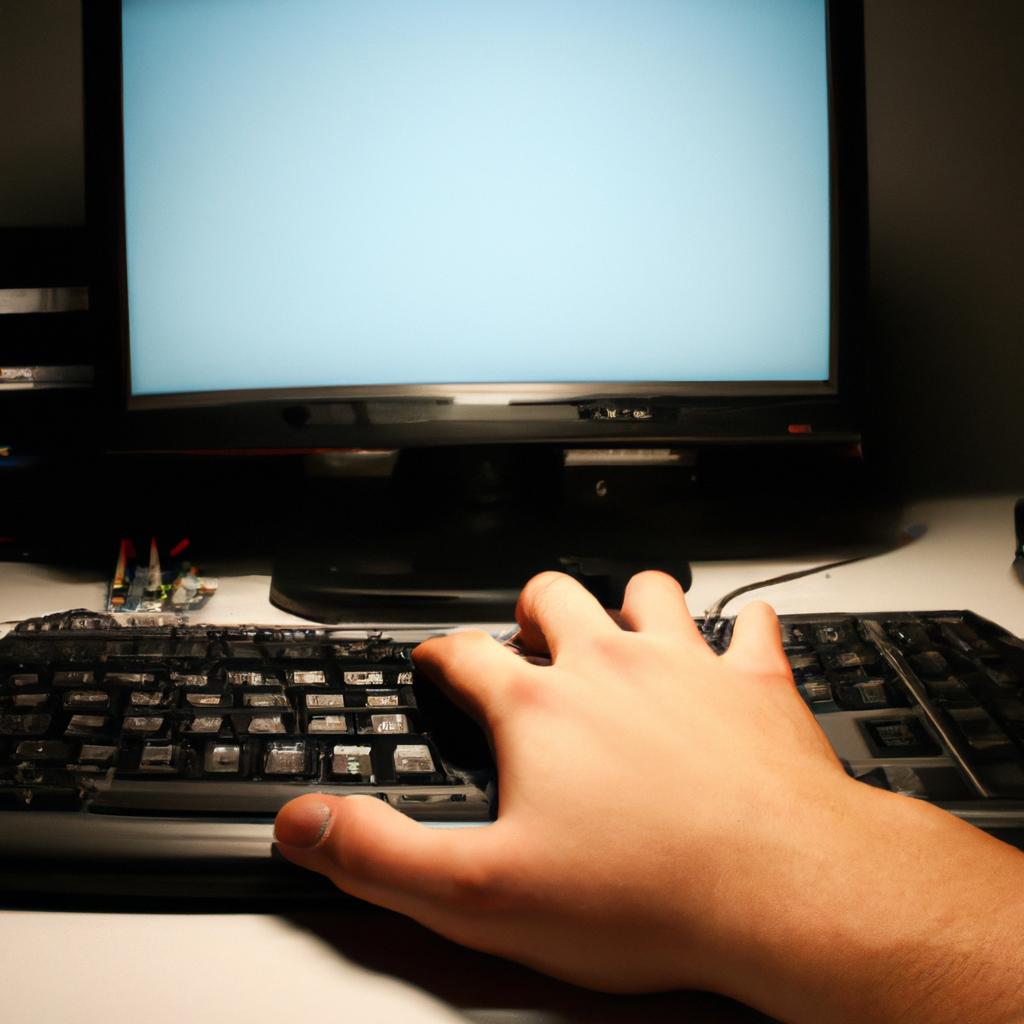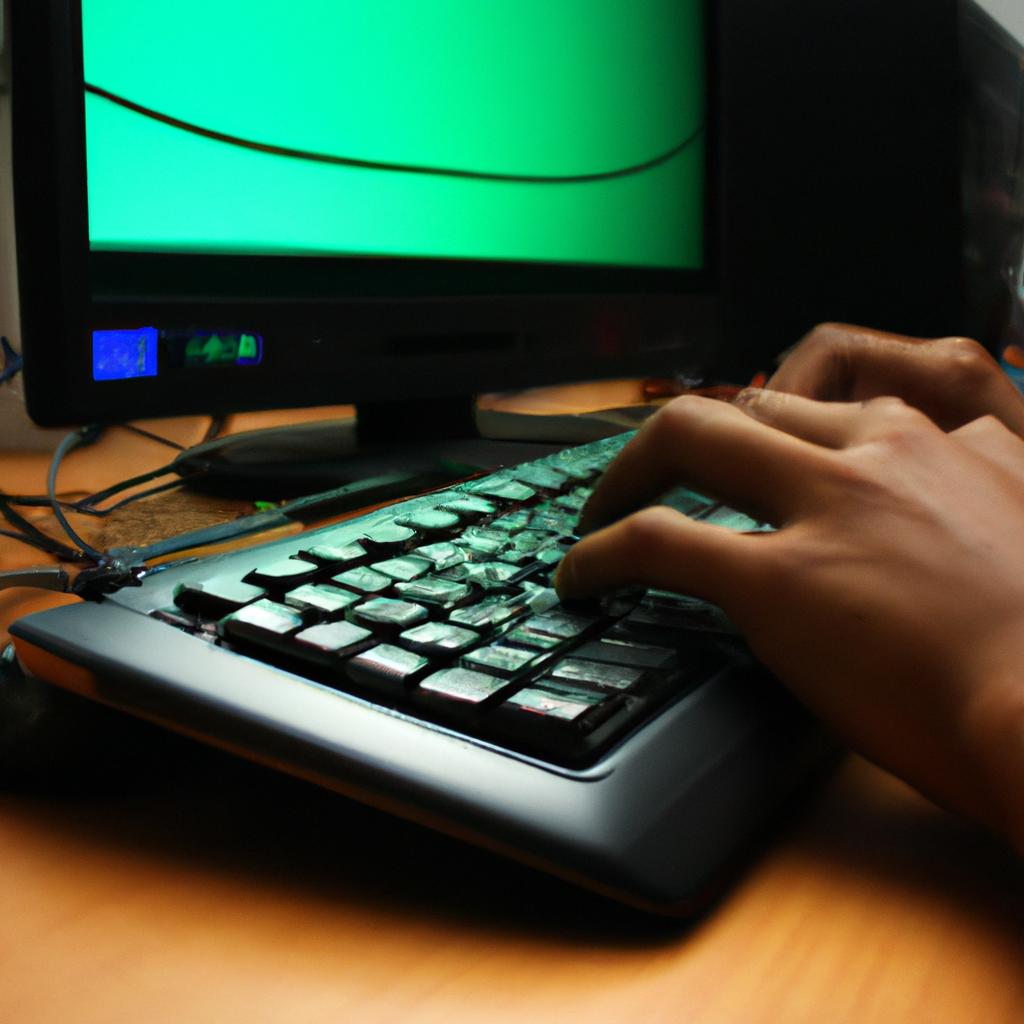Hardware Troubleshooting: Computers and Software Tech Loan Guide

Hardware troubleshooting is an essential skill for individuals working with computers and software systems. In this article, we will provide a comprehensive guide to hardware troubleshooting, focusing on the loaning of tech equipment. The aim is to equip readers with the necessary knowledge and strategies to address common hardware issues encountered in computer systems. To illustrate the significance of effective troubleshooting, consider a hypothetical scenario where a company’s entire network crashes due to a faulty router. The impact can be detrimental, leading to significant financial losses and disruption of business operations. Therefore, understanding how to identify and resolve hardware problems efficiently becomes crucial in maintaining system reliability.
The first section of this article will delve into the importance of proactive maintenance practices as part of hardware troubleshooting. By adhering to regular cleaning routines, checking cables and connectors for damage or wear, and updating firmware and drivers, users can prevent potential issues before they escalate into major disruptions. Additionally, proper handling techniques such as grounding oneself when touching sensitive components like RAM modules or processors will be discussed to minimize the risk of electrostatic discharge (ESD) damage.
In the subsequent section, we will explore various diagnostic tools that aid in identifying hardware failures accurately. These tools include built-in utilities provided by operating systems, third-party software solutions specifically designed for diagnosing hardware issues, and hardware diagnostic cards that can be inserted into expansion slots to detect faulty components. We will provide an overview of each tool, explaining their features and how they can be effectively used to pinpoint the root cause of hardware problems.
Once the issue has been identified, we will move on to discussing different troubleshooting techniques for common hardware failures. These include issues such as a non-responsive display, malfunctioning peripherals like keyboards or mice, overheating processors, and hard drive failures. For each problem, we will outline step-by-step instructions on how to troubleshoot and potentially resolve the issue.
In addition to addressing specific hardware failures, we will also cover general troubleshooting strategies that can be applied when encountering unknown or complex problems. These strategies involve isolating components, testing with known working parts, and utilizing event logs or error messages to narrow down potential causes.
Finally, we will touch upon the importance of documentation throughout the troubleshooting process. Keeping detailed records of all steps taken and solutions attempted is crucial for future reference and knowledge sharing within an organization. This documentation can help streamline future troubleshooting efforts by providing a comprehensive history of previous issues encountered and their resolutions.
By the end of this article, readers should have a solid understanding of proactive maintenance practices, diagnostic tools available for identifying hardware failures accurately, effective troubleshooting techniques for common hardware issues, general strategies for unknown or complex problems, and the significance of documenting troubleshooting efforts. Armed with this knowledge and skillset, individuals will be better equipped to handle hardware-related challenges efficiently and minimize downtime in computer systems.
Common Hardware Issues
Common Hardware Issues
Imagine this scenario: You sit down at your computer, ready to tackle a pressing task or indulge in some leisurely browsing. However, as you press the power button, nothing happens. Frustrated and perplexed, you find yourself facing one of the many common hardware issues that can plague computers. In this section, we will explore three prevalent hardware problems encountered by users and provide guidance on how to address them effectively.
Firstly, let’s consider the issue of overheating. Computers generate a significant amount of heat during operation due to their complex internal components working together tirelessly. If not properly managed, excessive heat can lead to performance degradation or even system failure. Signs of an overheating problem include sudden shutdowns or sluggishness in processing speed. To combat this issue:
- Ensure proper ventilation by keeping your computer in a well-ventilated area.
- Regularly clean dust from fans and air vents to facilitate better airflow.
- Consider using cooling pads or external fans for laptops if necessary.
- Monitor CPU temperatures using software tools designed for this purpose.
Another common hardware issue is random access memory (RAM) failure. Faulty RAM modules can cause unexpected computer crashes, frequent blue screens of death (BSOD), or application errors. To diagnose and resolve such problems:
| Steps | Actions |
|---|---|
| 1 | Power off the computer |
| 2 | Remove all RAM modules |
| 3 | Reinsert each module one at a time |
| 4 | Test the computer after inserting each module |
If faulty RAM is identified through this process, it may need replacement.
Lastly, connectivity issues with peripheral devices can be frustrating experiences. Whether it’s a printer refusing to communicate or an external hard drive failing to connect properly, these problems hinder productivity and disrupt workflow. When troubleshooting connectivity issues:
- Verify that cables are securely plugged in and not damaged.
- Update device drivers to ensure compatibility with your operating system.
- Restart the computer and peripheral devices before attempting reconnection.
- Consult user manuals or online resources for specific troubleshooting steps.
By addressing these common hardware issues, you can improve the overall performance and reliability of your computer system.
Software Troubleshooting Tips
Section 3: Resolving Software Problems
Imagine a scenario where you are working on an important project, and suddenly your computer freezes. Frustration sets in as you try to figure out what went wrong with the software. In this section, we will explore some effective strategies for troubleshooting common software issues.
Identifying the Problem:
To begin resolving software problems, it is crucial to identify the root cause of the issue. Consider a hypothetical situation where a user experiences frequent crashes while using a specific application. By analyzing error logs or conducting further investigation, one can determine whether the problem lies within the application itself, conflicts with other installed programs, insufficient system resources, or outdated drivers.
Troubleshooting Strategies:
- Check for updates:
- Ensure that all software applications and operating systems are up-to-date.
- Regularly install patches and security updates provided by developers.
- Scan for malware:
- Utilize reputable antivirus software to perform regular scans for malware and viruses.
- Malware infections may lead to slow performance or unexpected behavior of software applications.
- Clear temporary files:
- Deleting temporary files can help resolve issues related to excessive disk usage or sluggishness.
- Temporary files accumulate over time and can impact overall system performance.
- Reinstall problematic applications:
- If a particular program consistently exhibits malfunctioning behavior, consider uninstalling and reinstalling it.
- This process often resolves compatibility issues or corrupt installations.
Table: Emotional Response Eliciting Table – Advantages of Effective Software Troubleshooting
| Advantage | Description | Emotion |
|---|---|---|
| Enhanced productivity | Swift resolution of software problems leads to uninterrupted workflow | Satisfaction |
| Improved reliability | Reduced instances of software crashes and errors minimize frustration | Relief |
| Increased efficiency | Optimized system performance enables users to complete tasks more efficiently | Contentment |
| Enhanced user experience | Smooth operation of software applications enhances overall satisfaction | Delight |
By effectively resolving software issues, you can ensure a smoother computing experience.
Troubleshooting Network Connectivity
Imagine this scenario: You are working on an important project, trying to access a crucial document stored in the cloud. However, you suddenly find yourself unable to connect to the internet. Frustration sets in as you realize that your network connectivity is experiencing issues. In this section, we will explore common problems related to network connectivity and provide troubleshooting tips to help resolve them.
When faced with network connectivity problems, it is essential to identify the root cause before attempting any fixes. Some potential culprits for disrupted connections include:
- Misconfigured network settings.
- Hardware malfunctions such as faulty cables or routers.
- Interference from nearby electronic devices.
- Internet service provider (ISP) issues.
To effectively troubleshoot these problems, consider following these steps:
| Steps for Troubleshooting Network Connectivity |
|---|
| Check network settings and ensure they are correctly configured. |
| Inspect hardware components such as cables and routers for any damage or loose connections. |
| Minimize interference by moving away from other electronic devices emitting strong signals. |
| Contact your ISP to inquire about any known outages or disruptions in your area. |
By methodically addressing each of these potential causes, you can narrow down the issue and take appropriate action towards resolving it.
In summary, network connectivity problems can be frustrating but understanding their possible causes allows us to apply targeted solutions. By examining network settings, inspecting hardware components, minimizing interference, and contacting our ISP when necessary, we increase our chances of restoring uninterrupted internet access. Now let’s move on to exploring steps to diagnose and fix slow performance—an equally vital aspect of computer troubleshooting.
Transition Sentence: With our knowledge of troubleshooting network connectivity established, now let’s delve into the realm of diagnosing and fixing slow performance issues on computers.
Steps to Diagnose and Fix Slow Performance
Having explored the intricacies of troubleshooting network connectivity, let us now turn our attention towards addressing another common challenge faced by computer users – slow performance. To illustrate this issue, consider a hypothetical scenario where an individual is using their computer for work. They notice that their once lightning-fast machine has become sluggish, taking longer than usual to open applications and complete tasks.
Diagnosing and Fixing Slow Performance:
-
Identify Resource-Intensive Processes:
One potential cause for slow performance could be resource-intensive processes running in the background. These may include programs or services consuming excessive memory or CPU power. By identifying these culprits, users can take appropriate action to optimize system resources. This can involve closing unnecessary applications, disabling startup programs, or updating outdated software. -
Clear Temporary Files and Caches:
Over time, temporary files and caches accumulate on a computer’s hard drive, occupying valuable storage space and potentially slowing down overall performance. Regularly clearing these files can provide a noticeable boost to speed. Users can accomplish this through built-in disk cleanup utilities provided by their operating systems or third-party software tools designed specifically for cache removal. -
Perform System Maintenance Tasks:
Routine maintenance tasks are essential for ensuring optimal performance over an extended period. Users should regularly update installed software packages, including operating systems and antivirus programs, as new updates often contain bug fixes and performance enhancements. Additionally, performing regular scans with reputable antivirus software helps identify and remove malware that might contribute to system slowdowns.
The impact of slow computer performance extends beyond mere frustration; it affects productivity levels while having broader implications such as:
- Missed deadlines
- Decreased efficiency
- Increased stress levels
- Loss of business opportunities
Emotional Table:
| Challenges | Potential Solutions | Effects of Implementation |
|---|---|---|
| Missed Deadlines | Prioritize tasks, manage time effectively | Enhanced productivity and punctuality |
| Decreased Efficiency | Streamline workflow processes, utilize automation tools | Improved task completion rates and accuracy |
| Increased Stress Levels | Take regular breaks, practice stress management techniques | Boosted well-being and mental health |
| Loss of Business Opportunities | Optimize computer performance, stay up-to-date with industry trends | Competitive advantage, increased potential for growth |
Resolving Startup and Boot Issues:
As we delve into the next section on resolving startup and boot issues, it is essential to understand that a slow-performing system often manifests in multiple ways. By addressing these concerns systematically and employing appropriate troubleshooting techniques, users can regain control over their computers’ speed and efficiency.
Resolving Startup and Boot Issues
Building on our previous discussion about diagnosing and fixing slow performance, let’s now delve into resolving startup and boot issues. Imagine a scenario where you eagerly power up your computer, only to be greeted by an endless loading screen. This frustrating situation can hinder productivity and cause unnecessary stress. In this section, we will explore effective troubleshooting techniques that can help you overcome such difficulties.
Startup problems can manifest in various ways, ranging from system crashes to error messages or even complete failure to start up. To tackle these issues head-on, it is crucial to understand the underlying causes and take appropriate steps to rectify them. Here are some key points to consider when troubleshooting startup and boot problems:
- Check hardware connections: Ensure all cables and peripherals (such as monitors, keyboards, etc.) are securely connected. Loose or faulty connections can disrupt the boot process.
- Verify power supply: Confirm that the power source is functioning correctly by checking if other devices plugged into the same outlet are working properly.
- Examine software conflicts: Conflicting software applications or incompatible drivers can impede the startup process. Disable any recently installed programs or update outdated drivers.
- Run diagnostic tools: Utilize built-in diagnostic tools like BIOS/UEFI diagnostics or Windows Startup Repair to identify potential hardware or software failures.
Addressing startup and boot issues requires a systematic approach that accounts for both hardware and software factors involved in the initialization of your computer system. By following these guidelines, you can significantly increase your chances of resolving such problems effectively.
Now, let us transition smoothly into discussing another common area of concern – display and graphics problems – which often go hand in hand with startup issues. Troubleshooting Display and Graphics Problems involves identifying glitches in visual output, ensuring optimal resolution settings, addressing driver-related complications, among other aspects relevant to providing a seamless user experience.
Troubleshooting Display and Graphics Problems
Having covered the essential aspects of resolving startup and boot issues, we now delve into troubleshooting display and graphics problems. In this section, we will explore common challenges that users may encounter when it comes to their computer’s visual output.
Troubleshooting Display and Graphics Problems:
Example Scenario:
Consider a scenario where a user is experiencing distorted images on their monitor after installing new graphics drivers. The screen flickers intermittently, making it difficult for the individual to perform tasks effectively. This highlights the importance of addressing display-related concerns promptly.
Common Causes:
To identify the root cause behind display and graphics problems, consider these potential culprits:
- Outdated or incompatible graphics drivers.
- Faulty connections between hardware components (e.g., loose cables).
- Overheating issues affecting the video card.
- Malfunctioning displays due to physical damage or aging components.
Recommended Solutions:
When faced with display issues, try implementing the following solutions before seeking professional assistance:
- Update your graphics drivers to ensure compatibility with your system.
- Check all cable connections, ensuring they are securely plugged in at both ends.
- Monitor your computer’s internal temperature using software tools or by physically inspecting ventilation systems.
- Test your display on another device or connect an alternative monitor to determine if the issue lies within the display itself.
Table – Common Display and Graphics Problems:
| Problem | Possible Cause | Recommended Solution |
|---|---|---|
| Flickering Screen | Loose connections | Reconnect cables securely |
| Blurry Images | Incorrect resolution settings | Adjust resolution settings accordingly |
| No Signal | Disconnected cables | Ensure all required cables are connected |
| Distorted Colors | Faulty graphics card or display | Test with alternative hardware if possible |
By employing these troubleshooting techniques, users can overcome common display and graphics problems that may hinder their productivity. Remember to explore each potential cause systematically, testing solutions one by one until the issue is resolved. Ensuring a smooth visual experience contributes significantly to optimizing computer usage.
Note: It is important to consult professional assistance if the problem persists or if you are unsure about any steps involved in troubleshooting your display and graphics issues.






